We are not ghosts
How can sizeable towns with thousands of inhabitants be perceived as ‘ghost towns’? This question troubles locals in several post-mining communities across Kyrgyzstan but is nowhere voiced more often than in Mailuu-Suu, a 24,000-strong former uranium mining town in the country’s southern Dzhalal-Abad Province.
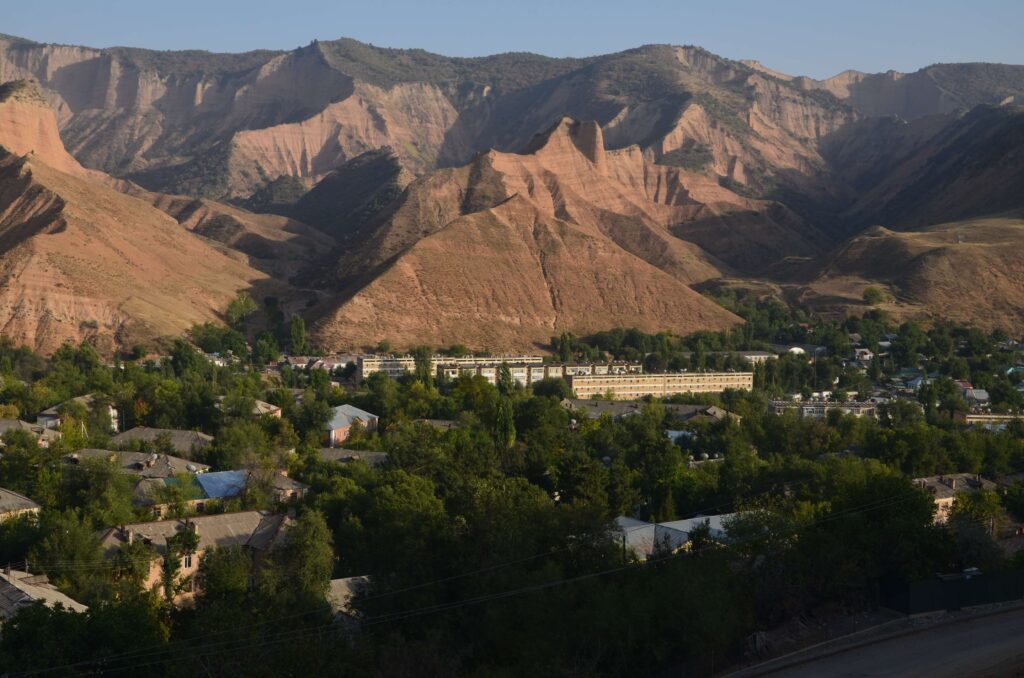
Mailuu-Suu’s population struggles with unemployment, outmigration, poverty, and all the other effects of post-Soviet de-industrialisation examined in this blog series. They also contend with the ‘slow violence’ (Nixon 2011) of long-term exposure to radionuclides and heavy metals, a toxic legacy that Mailuu-Suu inherited from the Soviet military-industrial complex. Between 1946 and 1968, Mailuu-Suu’s Western Mining and Chemical Combine provided the Soviet atomic programme with 10,000 tons of yellowcake, a partially refined form of uranium used as fuel in nuclear power stations and an intermediate step in the production of nuclear weapons.
But the combine also generated three million cubic meters of uranium waste rock and tailings, which were piled in slag heaps in the open air or buried in dumps scattered in the mountainous area surrounding the town. To this day, the town’s outskirts are dotted with ionising radiation warning symbols. Radioactive radon gas is present in the tap water. And Mailuu-Suu records unusually high rates of birth defects, miscarriages, and stillbirths, as well as a number of cancer patients twice the national average.
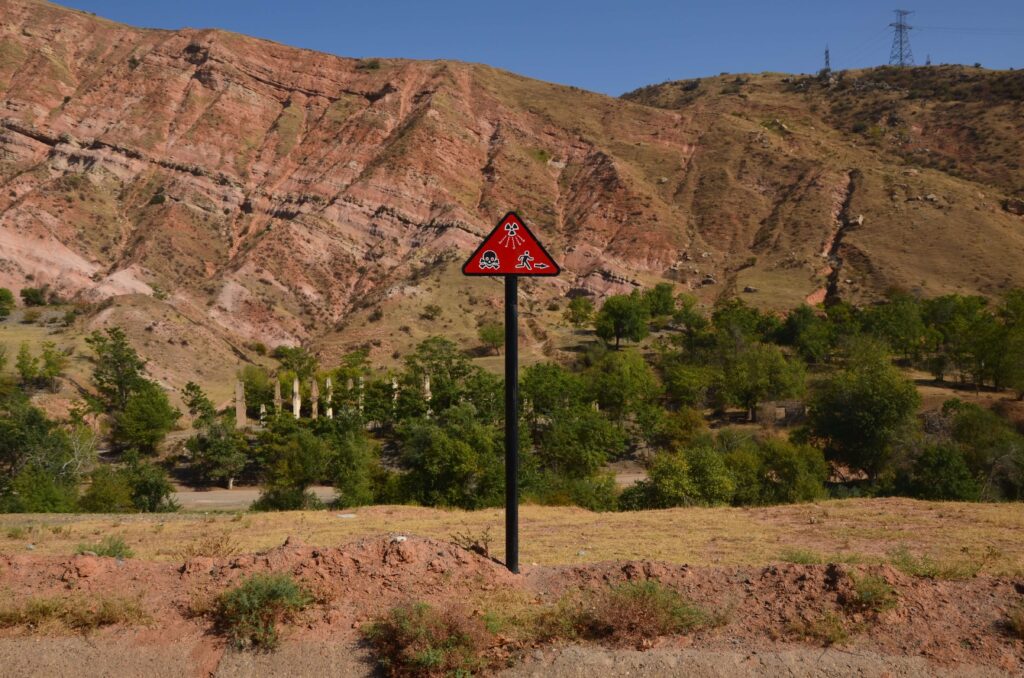
Socioeconomic ruination and near post-apocalyptic environmental degradation have prompted Kyrgyz and international media alike to routinely refer to Mailuu-Suu as a ‘ghost town’ (Russian: gorod-prizrak). The term has its origins in the late 19th century, when it was conceived to convey the abandonment, desertion, and decay experienced by many ‘gold rush’ boomtowns in the American West. Given that mining towns depend on the availability of a finite resource, ore depletion or a steep drop in the ore’s fluctuating price have historically transformed many of them overnight into ghost towns. In the 1950s, a sense of urgency to find and extract uranium to feed the US atomic programme spurred the US government to incentivise laymen to prospect for the ore, triggering an ‘uranium rush’ and leading to the establishment of yellowcake boomtowns catering for those involved. But in the mid-1960s, the US government phased out the policy, bringing the rush to a close (Zoellner 2010). As a result, many yellowcake boomtowns went bust and were abandoned (Amundson 2002).
Incidentally, around the same time, uranium deposits in Mailuu-Suu – at the time known as Maili-Sai – were nearing depletion, forcing the uranium combine to close in 1968. But unlike American yellowcake towns, the Soviet state did not let Mailuu-Suu go bust. As Elena Khlinovskaya Rockhill (2016: 60) observes, “the Soviet economy did not use such concepts as boom and bust… [Economic development] was based on the idea of unilinear progressive teleological evolutionism, an endless move forward, and expansion”.
Mailuu-Suu was transformed into an industrial centre and bestowed with the Soviet Union’s largest lightbulb factory – which gave the city its nickname, Light City (Russian: svetlyi gorod) – as well as several smaller plants and workshops. Educational facilities were opened to train locals in new crafts. Accomplished workers were sent to technical universities to complete their education. And skilled individuals from across the country moved to Mailuu-Suu in order to enjoy the privileges associated with direct provisioning from Moscow (Russian: Moskovskoe obespechenie), such as high salaries and a wide range of consumer goods. Far from meeting the fate of American yellowcake boomtowns, in 1989 Mailuu-Suu reached its population peak of 32,422. Where market capitalism sowed ghost towns, Soviet development gave mining towns a second life, even if this entailed motivating thousands of workers to unknowingly move to effectively contaminated areas.
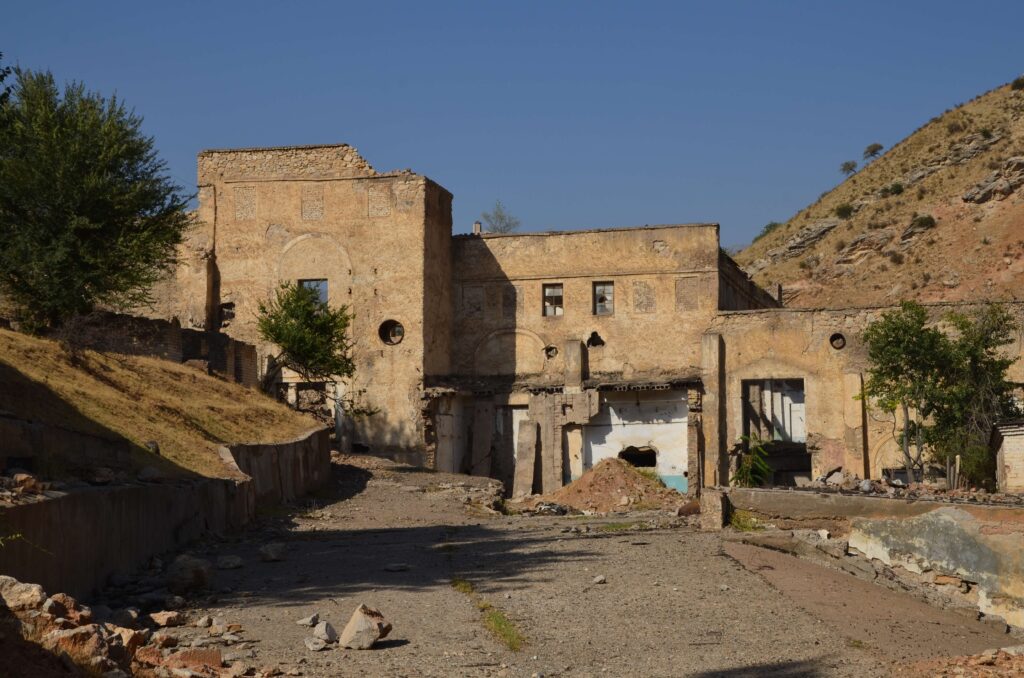
Mailuu-Suu eventually went bust in the years that followed the Soviet Union’s dissolution. The neoliberal pressures that accompanied the transition to market economy discontinued subsidies and liquidated enterprises perceived to be unprofitable. Factories were bought for peanuts by ‘investors’, who sold off the valuable machinery, and locals took apart what was left of the old buildings in order to reuse or sell whatever could be salvaged. Infrastructure was left to decay, the local combined heat and power (CHP) plant was taken off grid, and public transport was halted.
Most ethnically non-Kyrgyz residents – who until that point had constituted the majority of the population – emigrated to their titular republics, leaving behind empty residential buildings, which were progressively taken up by ethnic Kyrgyz from the surrounding villages. As Mailuu-Suu’s uranium tailings gained political significance, international experts flowed in to remediate the damage, in the process demolishing contaminated buildings and moving hundreds of thousands cubic meters of tailings and soil. Ruined infrastructure, ruined landscapes, and ruined bodies accentuated the loss and emptiness the town’s remaining population experienced.
Walking around Mailuu-Suu, one cannot shake off the feeling that something is missing. The town’s leafy streets are usually empty and cars are a rare sighting. Mailuu-Suu is a so-called ‘cul-de-sac-town’ (Russian: gorod-tupik), situated at the end of a dead-end road some 20km off the main Bishkek-Osh highway and hence is seldom visited by outsiders. To the feeling of emptiness adds the fact that for most of the year Mailuu-Suu is primarily inhabited by pensioners, women, and children. The town records one of the highest official unemployment rates in Kyrgyzstan and the vast majority of working-age men live and work in Russia, supporting their families through remittances. Those who can afford to fly return to Mailuu-Suu during the summer months to see their families, rest, and invest the money they earned abroad in houses, land, or cattle.
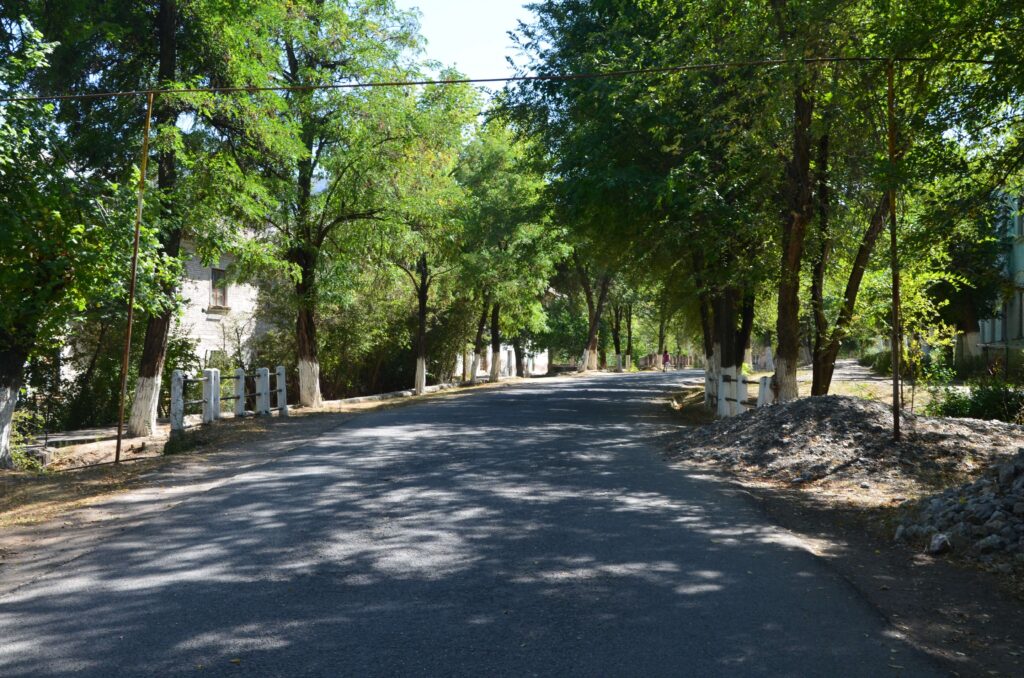
And yet, to claim that Mailuu-Suu is a ghost town is an exaggeration. While the official population count of approximately 24,000 is inflated, the town is nowhere close to desertion. In its central part, apartments are being renovated and vegetable gardens are looked after. The Soviet-era Univermag stands empty, but several small convenience stores provide locals with basic consumer goods. And dozens of students from nearby towns and villages study at Mailuu-Suu’s post-secondary educational institutions.
“Most of those writing that Mailuu-Suu is an abandoned ghost town have never been here,” remarked Anna Dumitrovna, historian and Vice-Rector of Mailuu-Suu Medical College, in Sep 2022. “Many young people move here. The number of our students constantly grows, and many settle in Mailuu-Suu after they graduate.”
My host Firuza is a case in point. A young woman who moved to Mailuu-Suu to study at the Medical College, she met her husband Ruslan and after graduation began to work as a nurse at the Mailuu-Suu Health Centre. Firuza’s monthly salary does not exceed $50, but thanks to money the couple earned in Russia, they bought a two-bedroom apartment in a Soviet-era building three years ago for $2,000. It is common for apartments to change hands for such amounts, as the abundance of empty housing pushes real estate prices down, making Mailuu-Suu one of the four towns with the most affordable housing in Kyrgyzstan.

In 2006, Mailuu-Suu was ranked among the 10 most polluted places in the world. This unflattering accolade continues to bring to the town dozens of ‘dark tourists’ every year. They voyeuristically wander among the empty carcasses of old industries, abandoned mineshafts, and radioactive tailings sites. Domestic tourism has played a role in revitalising Kadzhi-Sai, another former uranium mining town situated on the southern shore of lake Ysyk-Kol. Mailuu-Suu authorities have tried to put their town on the touristic map as well, but some locals are wary of foreigners reproducing via social media images that reinforce negative stereotypes and contribute to Mailuu-Suu being widely regarded as a ghost town.
In Aug 2021, I was photographing the town’s abandoned cinema (see Fig 6) when a car pulled up. “Why not photograph the beautiful House of Culture instead?” inquired the driver who introduced himself as Kadybek. After a brief exchange, Kadybek offered to drive me to a part of Mailuu-Suu that fits his idea of what a modern town should look like. “I always bring my guests here so that they see that we are not simply a depressed town with no contemporary buildings,” he told me when we entered the yard of the newly renovated Soviet-era building that now houses the Central Asian College. He had a relatively well-paid job in the still-functioning lightbulb factory, but his wife’s family in Dzhalal-Abad, the regional capital, did not think much of Mailuu-Suu.
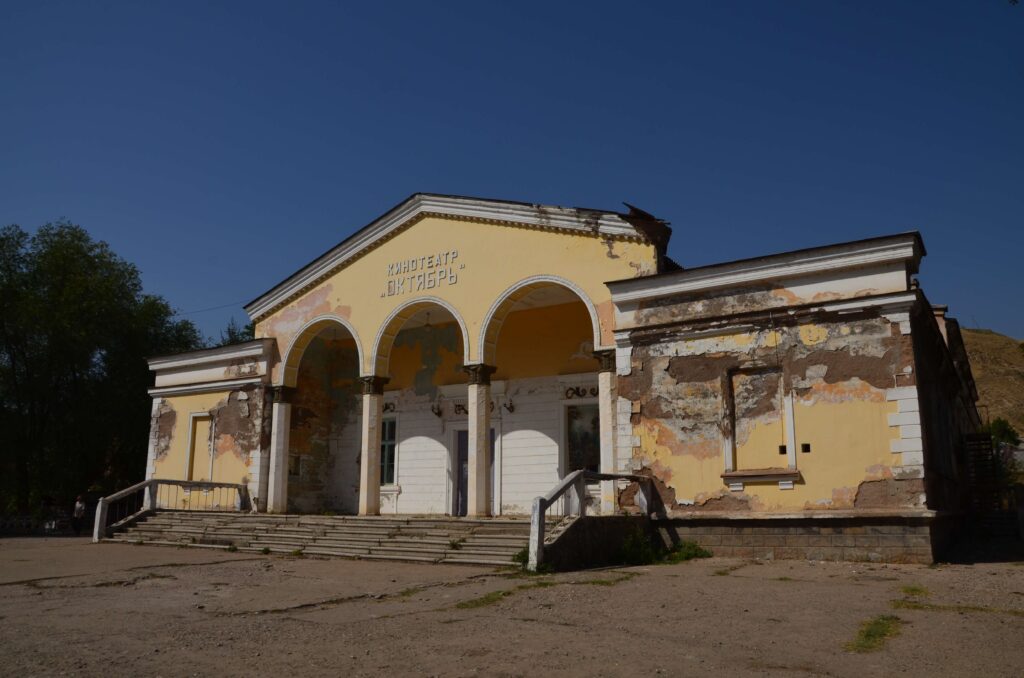
“People often portray Mailuu-Suu as the Kyrgyz Chernobyl,” Bakyt, a retired lightbulb factory assembler, told me. He supplements his meagre pension by working as a taxi driver. He continued:
But Mailuu-Suu is not Chernobyl. First, because there is no radiation here. And second, because we never left our town. Nobody lives there [in Chernobyl] anymore, but in Mailuu-Suu live 20,000 people. This is why, when people say that Mailuu-Suu is a ghost town, it upsets me, because they portray those who live here as ghosts. We are not ghosts.
In addition to demonstrating the locals’ dismissiveness of the hazards associated with Mailuu-Suu’s atomic past, such narratives reveal that to call Mailuu-Suu a ‘ghost town’ is an affront to the town’s remaining population. For it deprecates their staying on in Mailuu-Suu and their efforts to make ends meet despite all odds. It portrays them not as survivors of postsocialist ruination but as helpless post-apocalyptic shadows.
There is thus no denying that, while not a ghost town, the town is haunted – by its toxic legacy as much as by the ghosts of its prosperous past. Dismissing the former and highlighting the latter allows locals to idealise the Soviet era, which in turns produces lifeworlds informed not by troubling presences but by painful absences of what was once there, but no longer is. Thirty years after the Soviet Union’s dissolution, Mailuu-Suu’s remaining population continues to live with memories of the Light City, trying to make sense of how the bright future they were promised gave way to emptiness.